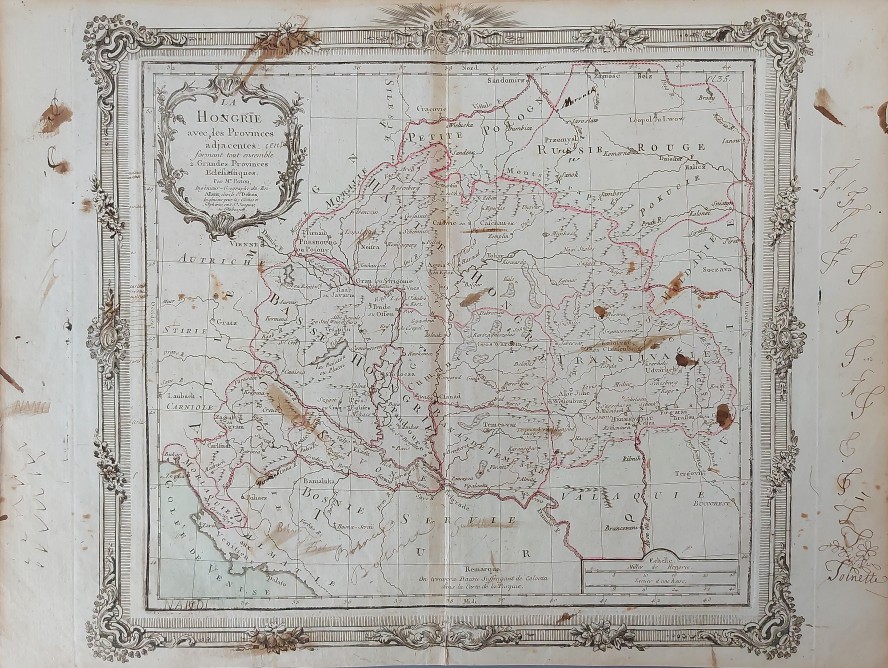
Title
La Hongrie avec les Provinces adjacentes formant tout ensemble2, Grandes Provinces Ecclésiastiques Par M. Brion Ingénieur-Géographe du Roi. A Paris chez le S. Desnos, Ingenieur pour les Globes et Sphère ruë St. Jacques, au Globe 1766.
Description
Striking and highly detailed fine unusual 1766 copper engraved map of Hungary and Transylvania (modern day Romania) by French cartographer Louis Brion de la Tour. The map covers the region from the Carpathian Mountains south as far as the Danube River, including parts of modern day Hungary, Romania, Slovakia and Serbia. Renders the entire region in extraordinary detail offering both topographical and political information.
Hungary at this time was under the role of Joseph II, a dynamic leader strongly influenced by the enlightenment. Joseph shook Hungary from its malaise when he inherited the throne from his mother, Maria Theresa. In the framework of Josephinism, Joseph sought to centralize control of the empire and to rule it by decree as an enlightened despot. He refused to take the Hungarian coronation oath to avoid being constrained by Hungary’s constitution. In 1781-82 Joseph issued a Patent of Toleration, followed by an edict of Tolerance which granted Protestants and Orthodox Christians full civil rights and Jews freedom of worship. He decreed that German replace Latin as the empire’s official language and granted the peasants the freedom to leave their holdings, to marry, and to place their children in trades. Hungary, Slavonia, Croatia, the Military Frontier and Transylvania became a single imperial territory under one administration, called the Kingdom of Hungary or ‘Lands of the Crown of St. Stephen.’
When the Hungarian nobles again refused to waive their exemption from taxation, Joseph banned imports of Hungarian manufactured goods into Austria and began a survey to prepare for imposition of a general land tax. Joseph’s reforms outraged nobles and clergy of Hungary, and the peasants of country grew dissatisfied with taxes, conscription, and requisitions of supplies. Hungarians perceived Joseph’s language reform as German cultural hegemony, and they reacted by insisting on the right to use their own tongue. As a result, Hungarian lesser nobles sparked a renaissance of the Hungarian language and culture, and a cult of national dance and costume flourished.
The lesser nobles questioned the loyalty of the magnates, of whom less than half were ethnic Hungarians, and even those had become French- and German-speaking courtiers. The Hungarian national reawakening subsequently triggered national revivals among the Slovak, Romanian, Serbian, and Croatian minorities within Hungary and Transylvania, who felt threatened by both German and Hungarian cultural hegemony. These national revivals later blossomed into the nationalist movements of the 19th and 20h centuries that contributed to the empire’s ultimate collapse.
A beautifully engraved title cartouche adorns the top left quadrant of the map.
This map was issued in the edition of Desnos’ 1766 “Atlas General Methodique et Elementaire, Pour l’Etude de la Geographie et de l’Histoire Moderne”.
Date
1766 ( dated )
Dimension
Paper size approx.: cm 38,2 x 28,4
Condition
Very strong and dark impression on good paper. Paper with chains. Map old original colored. Small margin to the top. Lower margin cut very shortly. Wide lateral margins. Corners partially missing. Small foxing and browning. Small tear at the lower side along central folding. Map folded. Conditions are as you can see in the images.
Mapmaker:
Louis Brion de la Tour (1743 - 1803) was the Cartographer Royal to the King of France, his official title being Ingenieur-Geographe du Roi, Despite a prolific cartographic career and several important atlases to his name, little is actually known of his life and career. He mat have been born in Bordeaux. His son of the same name was born in 1763 and published until his death in 1832. It is nearly impossible to distinguish the work of the father, from the work of the son, as both used the same imprint and were active in roughly the same period. Much of their work was published in partnership Louis Charles Desnos (fl. 1750 - 1790). Their most notable work is generally regarded to be his 1766 Atlas General.
Louis Charles Desnos (1725 - April 18, 1805) was an important 18th century instrument maker, cartographer and globe maker based in Paris, France. Desnos was born in Pont-Sainte-Maxence, Oise, France, the son of a cloth merchant. From April of 1745 he apprenticed at a metal foundry. Desnos married the widow of Nicolas Hardy, sone of the map, globe, and instrument seller Jacques Hardy. Desnos held the coveted position of Royal Globemaker to the King of Denmark, Christian VII, for which he received a stipend of 500 Livres annually. In return Desnos sent the King roughly 200 Livres worth of maps, books and atlases each year. As a publisher, Desnos produced a substantial corpus of work and is often associated with Zannoni and Louis Brion de la Tour (1756-1823). Despite or perhaps because of the sheer quantity of maps Desnos published he acquired a poor reputation among serious cartographic experts, who considered him undiscerning and unscrupulous regarding what he would and would not publish. Desnos consequently had a long history of legal battles with other Parisian cartographers and publishers of the period. It is said that he published everything set before him without regard to accuracy, veracity, or copyright law. Desnos maintained offices on Rue St. Jacques, Paris.